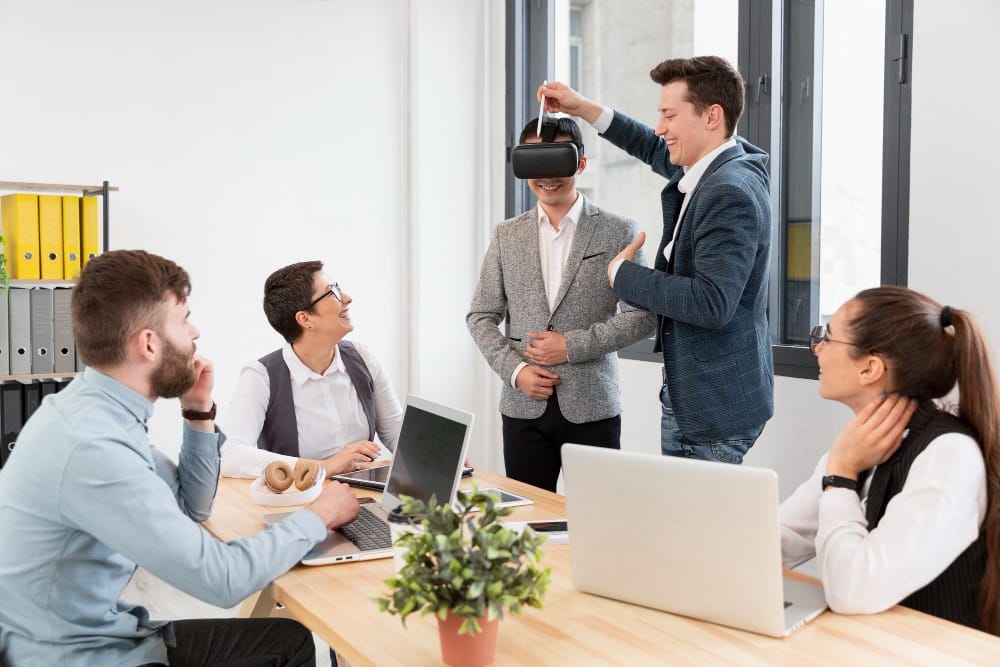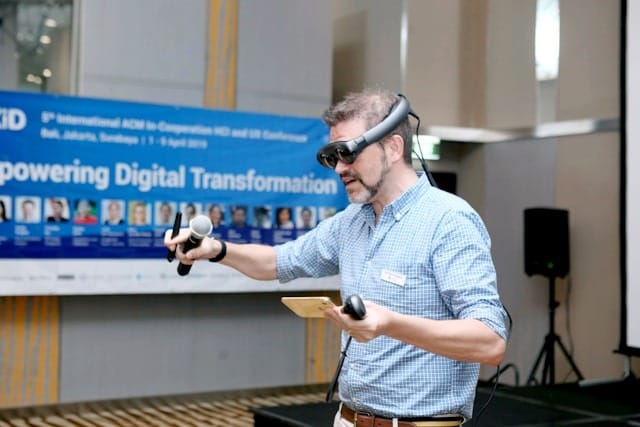Virtual Reality in Business: The Future of Brand Experience
By 2030, the global Virtual Reality (VR) market is projected to surpass $435 billion, driven by rapid adoption across industries. This cutting-edge technology, once confined to gaming, has now become a practical business tool, transforming how companies train employees, engage customers, and innovate. From immersive simulations to virtual showrooms, VR is redefining what's possible in the modern workplace.
In this article, we will explore how this immersive technology is redefining modern operations, along with the key benefits and challenges of using Virtual Reality in Business.
The Rise of VR in Business
Virtual Reality has moved far beyond entertainment to become a core driver of business transformation. Companies now use VR to visualize products, design prototypes, train employees, and even manage remote teams.
Many organizations are leveraging VR to reduce costs, improve safety, and enhance learning outcomes. For example, Boeing uses VR simulations to train mechanics in assembling aircraft components, reducing training time and human error. Similarly, hospitals employ VR in healthcare for surgical training, pain management, and patient therapy.
Use Cases for VR in Business
The scope of Virtual Reality in business is vast and expanding rapidly. Here are some real-world examples showing how various industries are integrating VR to gain a competitive edge:
1. Employee Training and Development

You can use VR in employee training to safely and cost-effectively simulate real-life work scenarios. For example, Walmart uses VR to train over a million employees in customer service, safety, and operations. This approach improves retention and engagement compared to traditional methods.
2. Product Design and Prototyping
Automotive companies like Ford and BMW employ VR for digital prototyping. Engineers can visualize a car's design in 3D, modify parts instantly, and reduce the cost of physical prototypes. This accelerates innovation while minimizing waste. Ford uses VR for training its technicians and mechanics. This has helped them reduce errors and injuries by 70% while improving service quality.
3. Healthcare and Medical Simulations
In VR in healthcare, surgeons practice procedures in a controlled, immersive environment. This not only improves accuracy but also reduces patient risk. Institutions like Johns Hopkins Medicine use VR to prepare surgeons for complex operations.
4. Virtual Showrooms and Customer Experience
Retailers are using VR to transform how customers browse and buy products. IKEA offers virtual showrooms where you can design and visualize home interiors before purchasing. Similarly, Nike and Adidas offer VR try-on experiences for online shopping that let customers see how products look and feel in real time. This creates personalized, engaging shopping experiences that drive conversions.
5. Real Estate and Architecture
In real estate, VR enables clients to take virtual property tours from anywhere in the world. Architects and developers can present immersive 3D models, allowing clients to visualize layout, lighting, and materials before construction begins. This streamlines communication, reduces revisions, and enhances client satisfaction. According to a ResearchGate report, 61% of real estate professionals believe that the use of AR/VR has given a competitive edge in the market.
6. Construction Planning and Safety
Construction firms use VR to plan complex projects, train workers, and ensure safety compliance. Through virtual site walkthroughs, you can detect design issues, coordinate between teams, and simulate hazardous situations without putting anyone at risk. Companies like Bechtel and Skanska use VR for pre-construction visualization and safety drills.
7. Marketing and Advertising
In marketing and advertising, VR helps brands tell stories that audiences can experience rather than just watch. Coca-Cola created an immersive "Santa's Sleigh Ride" VR campaign, while TOMS Shoes used VR to take customers on a virtual trip to see how their purchases help communities in need. These experiences foster emotional connections and brand loyalty.
8. Tourism and Hospitality
Hotels and travel agencies use VR to offer virtual previews of destinations. Marriott’s “VRoom Service” lets guests explore global destinations through VR headsets, inspiring bookings and enhancing customer excitement even before they travel.
Advantages of VR in Business
Implementing VR delivers several tangible benefits that can directly impact your organization's growth and efficiency. The advantages of VR in business include:

1. Enhanced Training Outcomes
VR immerses employees in realistic environments where they can practice skills repeatedly without the risks of the real world. This results in better retention, performance, and safety.
2. Cost and Time Efficiency
You can significantly reduce the need for physical resources, travel, and equipment. For example, VR onboarding saves thousands of dollars per trainee by minimizing instructor costs and material use.
3. Improved Collaboration
Virtual meeting spaces allow teams across continents to work together as if in the same room. This strengthens collaboration and creativity, particularly in design and strategy.
4. Superior Customer Engagement
Businesses use VR to offer interactive experiences such as virtual product demos or guided tours that engage customers emotionally and improve decision-making.
5. Innovation and Competitive Edge
Adopting VR early signals innovation. It positions your brand as a leader in adopting transformative technologies that enhance both operations and customer trust.
According to PwC, employees trained with VR complete training 4 times faster and are more confident in applying learned skills, underscoring how deeply VR impacts business outcomes.
Disadvantages of VR in Business
While the benefits are compelling, it's essential to understand the disadvantages of VR in business before full-scale adoption. Knowing these helps you plan better and avoid pitfalls.
1. High Initial Costs
Developing VR hardware, software, and custom applications can be expensive. Smaller businesses may find the upfront investment a barrier to entry.
2. Technical Limitations
VR systems require high computing power and stable network connectivity. Without this, performance and user experience suffer.
3. Health and Safety Concerns
Extended use of VR headsets can cause motion sickness, eye strain, and fatigue. Implementing proper usage policies is crucial.
4. Integration Challenges
VR tools often need to be aligned with existing business systems and workflows. Poor integration can reduce efficiency and ROI.
5. Limited Accessibility
Not all employees or customers have access to high-end VR devices, making widespread adoption uneven.
Despite these challenges, many organizations overcome them through careful planning, scalable pilot programs, and partnering with trusted VR solution providers.
Challenges and Considerations in Implementing VR in Business
While the potential of Virtual Reality in business is undeniable, implementing it effectively requires careful planning. As you consider adopting VR technology, several challenges and strategic factors must be addressed to ensure sustainable success.
1. High Implementation and Maintenance Costs
Although the cost of VR headsets and software has dropped over time, large-scale deployment can still be expensive. You need to consider hardware upgrades, software licenses, and developer costs. Conducting a cost-benefit analysis before implementation helps determine ROI.
2. Technical Expertise and Integration
Many organizations struggle to integrate VR solutions with existing systems like CRM or ERP software. Without adequate technical expertise, VR adoption can face bottlenecks. Partnering with experienced VR vendors or consulting firms ensures smoother transitions.
3. Data Privacy and Security
VR systems collect sensitive user data such as biometrics, voice, and behavioral patterns. You must comply with privacy regulations like GDPR or CCPA. Prioritize platforms that offer encrypted data storage and secure access.
4. Hardware Limitations
VR's effectiveness depends heavily on reliable hardware performance. Lag, low frame rates, or poor resolution can disrupt immersion and reduce engagement. Regular updates and testing can mitigate these issues.
5. User Comfort and Accessibility
Not all users adapt quickly to VR environments. Some may experience motion sickness or disorientation. Offering short sessions and ergonomic designs can enhance accessibility and comfort.
The Evolution of VR in Business
The evolution of VR in business has been remarkable. From early simulation systems in the 1990s to today's Mixed Reality environments, VR has evolved from an experimental concept into a practical business tool.
1. From Entertainment to Enterprise
Initially centered around gaming, VR has since made its way into mainstream enterprise applications. Industries such as healthcare, retail, real estate, and education now use VR to improve efficiency and engagement.
2. Hardware and Software Advancements
Modern headsets like the Meta Quest 3 and HTC Vive XR Elite provide ultra-realistic graphics and wireless experiences. On the software side, platforms like Unity and Unreal Engine enable businesses to build immersive and interactive environments without coding from scratch.
3. Integration with AI and Data Analytics
Today's VR systems can integrate with artificial intelligence and data analytics tools, enabling businesses to track user behavior, measure engagement, and optimize performance. This convergence drives personalized experiences and data-driven decisions.
4. Shift Toward Mixed and Extended Reality
The rise of Mixed Reality (MR) and Extended Reality (XR) demonstrates the next stage of evolution. These technologies blend digital and physical worlds, creating environments where users interact with both seamlessly.
The use of Virtual Reality in business has evolved from novelty to necessity. As technology advances, VR will become an integral part of business operations, just as mobile apps and cloud computing have.
Redefining Immersive Brand Experiences with Flam
In a world where attention spans are shrinking, brands must do more than advertise; they must immerse their customers. Flam makes that possible by helping brands create next-generation campaigns powered by immersive marketing. It enables them to transform traditional advertising into multi-sensory experiences that customers can explore, interact with, and remember.
Flam merges creativity, technology, and AI to help brands and enterprises design campaigns that bridge physical and digital engagement. Instead of static ads, brands can launch immersive brand spaces where audiences can see, feel, and connect with their story in real time.
How Flam Empowers Brands and Enterprises?
1. Interactive Marketing Campaigns
Businesses can use Flam to design and publish AR and VR-powered campaigns that turn static marketing assets into dynamic, shareable experiences. Brands leverage Flam to create immersive product launches, virtual exhibitions, and digital storytelling that strengthen brand identity and engagement.
2. Virtual Product Experiences
With Flam, enterprises can showcase products in 3D and VR environments, allowing customers to explore features, textures, and functionality virtually. This elevates customer trust and purchase confidence, especially in e-commerce and retail.
3. Brand Storytelling and Customer Engagement
Flam's AI-driven platform enables real-time analytics and personalization. Brands can craft campaigns that adapt to user behavior, delivering tailored experiences that leave lasting impressions. From AR-powered packaging to virtual brand tours, Flam transforms how brands connect with their audience.
4. Scalability and Integration
Flam supports large-scale deployments, making it ideal for global brands looking to unify marketing across markets. The platform integrates with existing digital ecosystems, allowing you to manage campaigns, measure engagement, and scale seamlessly.
Conclusion
Virtual Reality in business is redefining how you learn, work, and connect. It bridges imagination with execution, transforming training, design, and customer engagement into immersive experiences.
While cost and integration pose challenges, the benefits in efficiency, innovation, and engagement far outweigh them. Embracing VR today means preparing your business for a future where immersive technology defines competitive advantage.
Ready to take your brand into the immersive future? Empower your enterprise with Flam to create immersive experiences that drive real-world impact.